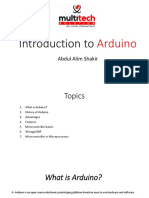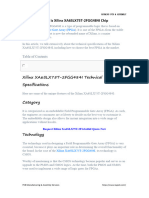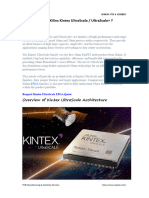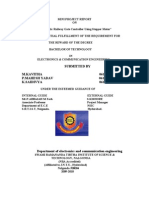What Is The Difference Between Arduino Nano and Arduino Micro
Uploaded by
jackWhat Is The Difference Between Arduino Nano and Arduino Micro
Uploaded by
jackRAYMING PCB & ASSEMBLY
What is the difference between Arduino Nano and Arduino Micro?
Introduction
Arduino is an open-source electronics platform that uses easy-to-program microcontroller boards and
software. The Arduino Nano and Arduino Micro are two popular small-form-factor boards in the Arduino
family. They provide compact, breadboard-friendly options for Arduino projects.
But what exactly are the differences between the Nano and Micro? This guide examines the key distinctions
in their specifications, design, hardware, and performance to help you select the right board for your needs.
Arduino Nano Overview
The Arduino Nano is one of the smallest classic Arduino boards, but still includes the essential components
needed for many projects. Here are some key features:
Microcontroller: ATmega328P
Operating Voltage: 5V
Digital I/O Pins: 22
Analog Input Pins: 8
Flash Memory: 32 KB
Clock Speed: 16 MHz
Physical Size: 18 x 45 mm
Mounting Holes: No
The Nano’s small size makes it well suited for breadboard use and space-constrained projects. Its pin layout
mirrors a standard Arduino Uno for easy migration between the boards. Overall, the Nano offers a versatile,
economic option for many entry-level and intermediate Arduino applications.
Request Arduino PCB Manufacturing & Assembly Quote
Arduino Micro Overview
PCB Manufacturing & Assembly Services https://www.raypcb.com/
RAYMING PCB & ASSEMBLY
The Arduino Micro is even smaller than the Nano but contains more powerful processor and networking
capabilities. Key features include:
Microcontroller: ATmega32U4
Operating Voltage: 5V
Digital I/O Pins: 20
Analog Input Pins: 12
Flash Memory: 32 KB
Clock Speed: 16 MHz
Physical Size: 18 x 33 mm
Mounting Holes: Yes
The Micro runs on the more advanced 32U4 processor, adding built-in USB communication support. Its
compact stamped form factor consumes minimal space. These advantages make the Micro a good choice for
projects involving USB connectivity or advanced processing in a tiny package.
Hardware Comparison
While the Nano and Micro share similarities in being small Arduino boards, they differ significantly in
their hardware design and component integration.
Processor/Microcontroller
Nano: ATmega328P – Common 8-bit AVR MCU, basic Arduino controller
Micro: ATmega32U4 – Enhanced 8-bit AVR with built-in USB support
The 32U4 gives the Micro native USB communication capability lacking on the 328P Nano.
Input/Output Pins
Nano Digital I/O: 22 pins
Nano Analog In: 8 pins
Nano PWM channels: 6
Micro Digital I/O: 20 pins
Micro Analog In: 12 pins
Micro PWM channels: 7
The Micro has 12 analog inputs versus 8 on the Nano, useful for more complex analog sensor applications.
Memory and Clock Speed
Nano Flash Memory: 32 KB
PCB Manufacturing & Assembly Services https://www.raypcb.com/
RAYMING PCB & ASSEMBLY
Nano SRAM: 2 KB
Nano EEPROM: 1 KB
Nano Clock Speed: 16 MHz
Micro Flash Memory: 32 KB
Micro SRAM: 2.5 KB
Micro EEPROM: 1 KB
Micro Clock Speed: 16 MHz
The memory configurations are nearly identical, with the Micro having slightly more SRAM. Both operate
at 16 MHz.
Power
Nano Input Voltage: 5-12V recommended, 7-12V required for some functions
Nano Power Connector: Mini-B USB
Micro Input Voltage: 5-12V recommended, 7-12V required for some functions
Micro Power Connector: Micro-B USB
The Nano and Micro both operate on 5V logic but can accept higher input voltages. The Micro uses the
smaller Micro-B USB connector.
Physical Size and Form Factor
Nano Length x Width: 18 x 45 mm
Nano Mounting Holes: No
Nano Form Factor: Rectangular PCB
Micro Length x Width: 18 x 33 mm
Micro Mounting Holes: Yes
Micro Form Factor: Stamped assembly with integrated USB connector
The Micro has a smaller footprint than the Nano. The stamped design with integrated USB plug provides a
more compact and rugged physical package.
Other Peripheral Hardware
Nano: No additional components beyond the microcontroller and basic I/O.
Micro: Integrated reset button and onboard LED; additional MCU peripherals like UART, SPI, I2C
supported.
The Micro design incorporates some built-in user interface features and takes advantage of the 32U4’s
peripherals.
PCB Manufacturing & Assembly Services https://www.raypcb.com/
RAYMING PCB & ASSEMBLY
Request Arduino PCB Manufacturing & Assembly Quote
Software Comparison
Smallest Arduino Board
The Nano and Micro also use different processor families that impact compatibility with Arduino software
libraries and cores.
Processor Family
Nano: ATmega328P (AVR 8-bit MCU)
Micro: ATmega32U4 (AVR 8-bit MCU)
Both are Atmel AVR chips but they require different cores to provide USB support on the Micro versus
UART on the Nano.
Arduino Cores
Nano: ATmega328P core
Micro: Leonardo core
The Leonardo core adds USB communication libraries. Most shields and libraries are compatible with both
cores.
Pin Mapping
Nano: ATmega328P Arduino pinout
Micro: ATmega32U4 Arduino pinout
PCB Manufacturing & Assembly Services https://www.raypcb.com/
RAYMING PCB & ASSEMBLY
Code written for Nano will need pin number changes to run on Micro. The pin functions match between
boards but not pin locations.
Memory Management
Nano: Standard Arduino memory management
Micro: Enhanced memory management in Leonardo core
The Micro can more efficiently utilize its SRAM memory space than the Nano with the 328P core.
Performance Comparison
The Nano and Micro overall have generally comparable performance, but the Micro’s 32U4 architecture and
USB support provide some advantages for specific use cases.
Processing Speed
Nano and Micro: Both 16 MHz clock speed
The two boards operate at the same 16 MHz frequency and thus equivalent raw processing rates.
Input/Output Speed
Nano: Standard I/O performance
Micro: Slightly faster I/O operation for analog and PWM functions
The 32U4 MCU implements some peripheral functions like ADC and timers in a more optimized fashion.
Interface Speed
Nano: UART capped at 2 Mbps
Micro: Hi-speed USB 2.0 with transfer rates up to 480 Mbps
The Micro’s integrated USB connectivity provides vastly faster throughput than the UART interface on the
Nano.
Responsiveness
Nano: Some delays managing USB-serial coordination
Micro: Native USB operation avoids UART delays
PCB Manufacturing & Assembly Services https://www.raypcb.com/
RAYMING PCB & ASSEMBLY
USB HID allows lower latency control of the Micro from a host computer compared to Nano’s conversion
between USB and serial.
Program Storage
Nano: 32 KB flash for storing sketches
Micro: 32 KB flash for storing sketches
Both provide the same size 32 KB flash memory for storing Arduino sketches.
Cost Comparison
The Nano and Micro have similar manufacturing costs in the same low price range:
Arduino Nano pricing: Approximately $22 – $25
Arduino Micro pricing: Approximately $20 – $25
For either board, 3rd party clones can be purchased often for $10 or less.
In summary, the cost is essentially equivalent between both models when sourcing original Arduino or clone
boards. Cost does not need to be a determining factor.
Usage Comparison
The Nano and Micro lend themselves to somewhat different use cases based on their size, design, and
hardware differences:
Arduino Nano Typical Uses:
Basic microcontroller learning and experimentation
Physical computing projects with simple interfacing
Robotics applications not requiring USB
IOT sensor nodes using wireless communication
Arduino Micro Typical Uses:
Projects involving USB connectivity to PC or other devices
IOT end-nodes that require wired USB networking
Advanced or complex sensor systems
Tightly space constrained applications
Handheld control/monitoring with PC interface
PCB Manufacturing & Assembly Services https://www.raypcb.com/
RAYMING PCB & ASSEMBLY
Shared Applications:
Simple LEDs, buttons, motor control
Analog sensor readout and data logging
Low-speed human interface devices like game controllers
For projects with these basic embedded control needs, either Nano or Micro could suffice. The smaller form
factor Micro may work better in tightly constrained spaces.
Request Arduino PCB Manufacturing & Assembly Quote
Summary Comparison
Parameter Arduino Nano Arduino Micro
Microcontroller ATmega328P ATmega32U4
Digital I/O Pins 22 20
Analog In Pins 8 12
Clock Speed 16 MHz 16 MHz
Flash Memory 32 KB 32 KB
SRAM 2 KB 2.5 KB
EEPROM 1 KB 1 KB
Operating Voltage 5-12V 5-12V
USB Support UART serial Native USB
Physical Size 45 x 18 mm 33 x 18 mm
Form Factor PCB Board Stamped module
Price Range $22 – $25 $20 – $25
Conclusion
PCB Manufacturing & Assembly Services https://www.raypcb.com/
RAYMING PCB & ASSEMBLY
In summary, the Arduino Nano and Micro share similarities in their compact format and basic
microcontroller capabilities. But key differences exist in their I/O configuration, physical design, and
especially USB support that impact their use in various applications:
The Nano provides a compact, no-frills option for basic Arduino projects not requiring USB. Its
rectangular PCB shape and standard pin layout offer versatility.
The Micro is best for advanced projects needing USB native connectivity to PC or other devices.
Its tiny, stamped footprint can fit into the smallest spaces.
For projects that simply need a small Arduino board without USB or specificity on form factor, the lower
cost Nano is likely the better choice. But for space-constrained applications requiring direct USB integration,
the Micro’s advantages stand out. Understanding these tradeoffs allows selecting the right board for each
project’s needs.
Frequently Asked Questions
Here are some common questions about the Arduino Nano and Micro:
Can shields be used with the Nano and Micro boards?
Yes, both Nano and Micro are compatible with standard Arduino Uno shields since they have the same
operating voltage and I/O pin capabilities. However, the smaller physical size may block some shield
attachments in compact layouts.
How difficult is transitioning code between the Nano and Micro?
The code can usually be adapted quite easily by changing pin numbers to match the different layouts. But
sketches relying on UART serial functions will require changes to use the Micro’s USB capabilities instead.
How do you connect the Nano and Micro to a computer?
The Nano requires a separate USB-to-UART adapter, while the Micro provides built-in USB connectivity.
Nano thus needs extra wiring and components to interface with USB.
Can the Nano or Micro be battery powered?
Yes, both boards can run on batteries or other standalone power supplies from 5-12V. Avoid exceeding 12V
maximum input voltage to prevent damage. The Micro’s size can be advantageous for portable,
battery-operated devices.
PCB Manufacturing & Assembly Services https://www.raypcb.com/
RAYMING PCB & ASSEMBLY
Which board is more beginner friendly?
For complete beginners, the Nano is likely easier to start with since its functionality matches the familiar
Uno. After gaining experience, the Micro’s extra features become more useful. The Micro may seem more
complex at first.
Conclusion
The Arduino Nano and Micro each have specialized strengths for different applications. Understanding their
key hardware and software differences allows selecting the right board to best meet the needs of a particular
microcontroller project. For basic low-cost Arduino projects, the Nano provides a compact solution. Where
advanced processing and USB connectivity are required, the Micro is likely the superior choice.
Related Posts:
1. Which is the best to use between Arduino Leonardo and Arduino UNO
2. What is Micro Sectioning on a PCB (Microsection)?
3. What are the Functions of the Pro Micro Pinout?
4. Applications and Advantages of an SMD Micro Switch
https://www.raypcb.com/arduino-nano-vs-micro/
PCB Manufacturing & Assembly Services https://www.raypcb.com/
You might also like
- CompTIA A+ CertMike: Prepare. Practice. Pass the Test! Get Certified!: Core 1 Exam 220-1101From EverandCompTIA A+ CertMike: Prepare. Practice. Pass the Test! Get Certified!: Core 1 Exam 220-1101No ratings yet
- PlayStation Architecture: Architecture of Consoles: A Practical Analysis, #6From EverandPlayStation Architecture: Architecture of Consoles: A Practical Analysis, #6No ratings yet
- Arduino: The ultimate guide to Arduino, including projects, programming tips & tricks, and much more!From EverandArduino: The ultimate guide to Arduino, including projects, programming tips & tricks, and much more!No ratings yet
- What Is The Best Smallest Arduino Board in The MarketNo ratings yetWhat Is The Best Smallest Arduino Board in The Market15 pages
- Why Arduino ATmega 32u4 Is A Highly Preferred Microcontroller BoardNo ratings yetWhy Arduino ATmega 32u4 Is A Highly Preferred Microcontroller Board12 pages
- What Is An ArduinoTypes, Projects and ApplicationsNo ratings yetWhat Is An ArduinoTypes, Projects and Applications16 pages
- GameCube Architecture: Architecture of Consoles: A Practical Analysis, #10From EverandGameCube Architecture: Architecture of Consoles: A Practical Analysis, #10No ratings yet
- Wii U Architecture: Architecture of Consoles: A Practical Analysis, #21From EverandWii U Architecture: Architecture of Consoles: A Practical Analysis, #21No ratings yet
- Arduino For Beginners: How to get the most of out of your Arduino, including Arduino basics, Arduino tips and tricks, Arduino projects and more!From EverandArduino For Beginners: How to get the most of out of your Arduino, including Arduino basics, Arduino tips and tricks, Arduino projects and more!No ratings yet
- Game Boy Advance Architecture: Architecture of Consoles: A Practical Analysis, #7From EverandGame Boy Advance Architecture: Architecture of Consoles: A Practical Analysis, #7No ratings yet
- C Programming for the Pc the Mac and the Arduino Microcontroller SystemFrom EverandC Programming for the Pc the Mac and the Arduino Microcontroller SystemNo ratings yet
- Mega Drive Architecture: Architecture of Consoles: A Practical Analysis, #3From EverandMega Drive Architecture: Architecture of Consoles: A Practical Analysis, #3No ratings yet
- Neo Geo Architecture: Architecture of Consoles: A Practical Analysis, #23From EverandNeo Geo Architecture: Architecture of Consoles: A Practical Analysis, #23No ratings yet
- Arduino: The complete guide to Arduino for beginners, including projects, tips, tricks, and programming!From EverandArduino: The complete guide to Arduino for beginners, including projects, tips, tricks, and programming!4.5/5 (4)
- NES Architecture: Architecture of Consoles: A Practical Analysis, #1From EverandNES Architecture: Architecture of Consoles: A Practical Analysis, #15/5 (1)
- ES Lecture Sept28 - MCs Vs Onboard ComputersNo ratings yetES Lecture Sept28 - MCs Vs Onboard Computers35 pages
- PC Engine / TurboGrafx-16 Architecture: Architecture of Consoles: A Practical Analysis, #16From EverandPC Engine / TurboGrafx-16 Architecture: Architecture of Consoles: A Practical Analysis, #16No ratings yet
- What Is The Difference Between Microcontroller and MicroprocessorNo ratings yetWhat Is The Difference Between Microcontroller and Microprocessor15 pages
- Digital Electronics, Computer Architecture and Microprocessor Design PrinciplesFrom EverandDigital Electronics, Computer Architecture and Microprocessor Design PrinciplesNo ratings yet
- Arduino: The Ultimate Guide to Arduino for Beginners Including Arduino Basics, Tips & Tricks, Projects, and More!From EverandArduino: The Ultimate Guide to Arduino for Beginners Including Arduino Basics, Tips & Tricks, Projects, and More!No ratings yet
- The Working Principles of ESP32 and Analytical Comparison of Using Low-Cost Microcontroller Modules inNo ratings yetThe Working Principles of ESP32 and Analytical Comparison of Using Low-Cost Microcontroller Modules in6 pages
- Nintendo 64 Architecture: Architecture of Consoles: A Practical Analysis, #8From EverandNintendo 64 Architecture: Architecture of Consoles: A Practical Analysis, #8No ratings yet
- An5780 Migration of Applications From Atmega328 Family To Stm32c0 Series Microcontrollers StmicroelectronicsNo ratings yetAn5780 Migration of Applications From Atmega328 Family To Stm32c0 Series Microcontrollers Stmicroelectronics25 pages
- Nintendo DS Architecture: Architecture of Consoles: A Practical Analysis, #14From EverandNintendo DS Architecture: Architecture of Consoles: A Practical Analysis, #14No ratings yet
- Making Laser Engraving Circuit Boards in ElectronicsNo ratings yetMaking Laser Engraving Circuit Boards in Electronics13 pages
- ARDUINO PROGRAMMING FOR BEGINNERS: A Comprehensive Beginner's Guide to Learn the Realms of Arduino Programming from A-ZFrom EverandARDUINO PROGRAMMING FOR BEGINNERS: A Comprehensive Beginner's Guide to Learn the Realms of Arduino Programming from A-Z4/5 (1)
- Analyzing Key Microcontroller PCB Characteristics For Embedded DesignNo ratings yetAnalyzing Key Microcontroller PCB Characteristics For Embedded Design9 pages
- Why Is The Panasonic R-F705S Useful For Mobile and Automotive ProductsNo ratings yetWhy Is The Panasonic R-F705S Useful For Mobile and Automotive Products4 pages
- Why You Should Choose The Shengyi S7439G PCB MaterialNo ratings yetWhy You Should Choose The Shengyi S7439G PCB Material5 pages
- Why OEM Circuit Boards Are Ideal For Use in Several ApplicationsNo ratings yetWhy OEM Circuit Boards Are Ideal For Use in Several Applications6 pages
- Xilinx XAZU2EG-1SBVA484I Fpga ApplicationNo ratings yetXilinx XAZU2EG-1SBVA484I Fpga Application5 pages
- Why The Arlon 49N PCB Material Is Useful in High Temperature or High Performance ApplicationsNo ratings yetWhy The Arlon 49N PCB Material Is Useful in High Temperature or High Performance Applications4 pages
- Why Non Recurring Engineering Cost (NRE Charge) Is Important For Your PCBNo ratings yetWhy Non Recurring Engineering Cost (NRE Charge) Is Important For Your PCB4 pages
- Why A PCB Ground Plane Is Crucial For PCB FunctioningNo ratings yetWhy A PCB Ground Plane Is Crucial For PCB Functioning3 pages
- Why Is The Home Energy Monitor ImportantNo ratings yetWhy Is The Home Energy Monitor Important7 pages
- Why 3D Print PCBs Matter in Today's Electronics ProductionNo ratings yetWhy 3D Print PCBs Matter in Today's Electronics Production4 pages
- Who Are The Leading Electrical Coil ManufacturersNo ratings yetWho Are The Leading Electrical Coil Manufacturers5 pages
- Where Does The QuickLogic Eclipse FPGA Architecture Family Play A RoleNo ratings yetWhere Does The QuickLogic Eclipse FPGA Architecture Family Play A Role11 pages
- Where To Buy Rogers RT Duroid 5880 LaminateNo ratings yetWhere To Buy Rogers RT Duroid 5880 Laminate5 pages
- What Is The Significance of Home Electronics PCBNo ratings yetWhat Is The Significance of Home Electronics PCB6 pages
- What Is The Significance of ENIG Plating ThicknessNo ratings yetWhat Is The Significance of ENIG Plating Thickness4 pages
- What Is Xilinx Spartan-7 Its Datasheet and Reference DesignsNo ratings yetWhat Is Xilinx Spartan-7 Its Datasheet and Reference Designs20 pages
- What Is The Purpose and Applications of A PCB MotherboardNo ratings yetWhat Is The Purpose and Applications of A PCB Motherboard4 pages
- What Is The Significance of IOT in AgricultureNo ratings yetWhat Is The Significance of IOT in Agriculture8 pages
- What Is Signal Integrity A Comprehensive OverviewNo ratings yetWhat Is Signal Integrity A Comprehensive Overview9 pages
- What Is The Difference Between ARM and FPGA ProcessorsNo ratings yetWhat Is The Difference Between ARM and FPGA Processors9 pages
- What Is SMT Soldering Process Step by StepNo ratings yetWhat Is SMT Soldering Process Step by Step12 pages
- What Is Thermal Consideration in PCB DesignNo ratings yetWhat Is Thermal Consideration in PCB Design6 pages
- What Is The Difference Between FFC Connector and FPC ConnectorNo ratings yetWhat Is The Difference Between FFC Connector and FPC Connector14 pages
- What Is Xilinx Kintex UltraScale UltraScale+No ratings yetWhat Is Xilinx Kintex UltraScale UltraScale+8 pages
- What Is The Difference Between Clean Flux and No Clean Flux Off PCBNo ratings yetWhat Is The Difference Between Clean Flux and No Clean Flux Off PCB13 pages
- Fan Regulator Using 8051 MicrocontrollerNo ratings yetFan Regulator Using 8051 Microcontroller2 pages
- Microcontroller Based Automatic Railway Gate Control100% (3)Microcontroller Based Automatic Railway Gate Control21 pages
- Microprocessor System Design AVR Microcontroller: Omid Fatemi100% (1)Microprocessor System Design AVR Microcontroller: Omid Fatemi39 pages
- Microcontrollers - Types & Applications What Is A Microcontroller?100% (1)Microcontrollers - Types & Applications What Is A Microcontroller?5 pages
- Automatic Railway Gate Controller Documentation67% (3)Automatic Railway Gate Controller Documentation53 pages
- Design and Implementation of Microcontroller Based Controller For Direction and Speed of A Robot100% (1)Design and Implementation of Microcontroller Based Controller For Direction and Speed of A Robot65 pages
- Infineon-CY8CKIT-062S2-43012 PSoC 62S2 Wi-Fi BT Pioneer Kit Guide-UserManual-v01 00-ENNo ratings yetInfineon-CY8CKIT-062S2-43012 PSoC 62S2 Wi-Fi BT Pioneer Kit Guide-UserManual-v01 00-EN51 pages
- Iot Based Home Automation System With Pattern Recognition: Ritvik Iyer, Antara SharmaNo ratings yetIot Based Home Automation System With Pattern Recognition: Ritvik Iyer, Antara Sharma5 pages
- Microcontroller Lecture Notes Module IIINo ratings yetMicrocontroller Lecture Notes Module III88 pages
- GPS and GSM Based Automatic Vehicle Accident Information SystemNo ratings yetGPS and GSM Based Automatic Vehicle Accident Information System14 pages
- Accident-Statistics,-Buzzer-During-Any-Accident DOCUMENTATION0% (1)Accident-Statistics,-Buzzer-During-Any-Accident DOCUMENTATION13 pages
- 1.Dr - Mohamed Abdel Motelb - Introduction To ComputerNo ratings yet1.Dr - Mohamed Abdel Motelb - Introduction To Computer12 pages
- CompTIA A+ CertMike: Prepare. Practice. Pass the Test! Get Certified!: Core 1 Exam 220-1101From EverandCompTIA A+ CertMike: Prepare. Practice. Pass the Test! Get Certified!: Core 1 Exam 220-1101
- PlayStation Architecture: Architecture of Consoles: A Practical Analysis, #6From EverandPlayStation Architecture: Architecture of Consoles: A Practical Analysis, #6
- Arduino: The ultimate guide to Arduino, including projects, programming tips & tricks, and much more!From EverandArduino: The ultimate guide to Arduino, including projects, programming tips & tricks, and much more!
- Exploring Arduino: Tools and Techniques for Engineering WizardryFrom EverandExploring Arduino: Tools and Techniques for Engineering Wizardry
- Arduino: A Beginner's Guide to Arduino ProgrammingFrom EverandArduino: A Beginner's Guide to Arduino Programming
- What Is The Best Smallest Arduino Board in The MarketWhat Is The Best Smallest Arduino Board in The Market
- Why Arduino ATmega 32u4 Is A Highly Preferred Microcontroller BoardWhy Arduino ATmega 32u4 Is A Highly Preferred Microcontroller Board
- What Is An ArduinoTypes, Projects and ApplicationsWhat Is An ArduinoTypes, Projects and Applications
- GameCube Architecture: Architecture of Consoles: A Practical Analysis, #10From EverandGameCube Architecture: Architecture of Consoles: A Practical Analysis, #10
- Wii U Architecture: Architecture of Consoles: A Practical Analysis, #21From EverandWii U Architecture: Architecture of Consoles: A Practical Analysis, #21
- Arduino For Beginners: How to get the most of out of your Arduino, including Arduino basics, Arduino tips and tricks, Arduino projects and more!From EverandArduino For Beginners: How to get the most of out of your Arduino, including Arduino basics, Arduino tips and tricks, Arduino projects and more!
- Game Boy Advance Architecture: Architecture of Consoles: A Practical Analysis, #7From EverandGame Boy Advance Architecture: Architecture of Consoles: A Practical Analysis, #7
- C Programming for the Pc the Mac and the Arduino Microcontroller SystemFrom EverandC Programming for the Pc the Mac and the Arduino Microcontroller System
- Mega Drive Architecture: Architecture of Consoles: A Practical Analysis, #3From EverandMega Drive Architecture: Architecture of Consoles: A Practical Analysis, #3
- Neo Geo Architecture: Architecture of Consoles: A Practical Analysis, #23From EverandNeo Geo Architecture: Architecture of Consoles: A Practical Analysis, #23
- Arduino: The complete guide to Arduino for beginners, including projects, tips, tricks, and programming!From EverandArduino: The complete guide to Arduino for beginners, including projects, tips, tricks, and programming!
- NES Architecture: Architecture of Consoles: A Practical Analysis, #1From EverandNES Architecture: Architecture of Consoles: A Practical Analysis, #1
- PC Engine / TurboGrafx-16 Architecture: Architecture of Consoles: A Practical Analysis, #16From EverandPC Engine / TurboGrafx-16 Architecture: Architecture of Consoles: A Practical Analysis, #16
- What Is The Difference Between Microcontroller and MicroprocessorWhat Is The Difference Between Microcontroller and Microprocessor
- Digital Electronics, Computer Architecture and Microprocessor Design PrinciplesFrom EverandDigital Electronics, Computer Architecture and Microprocessor Design Principles
- Arduino: The Ultimate Guide to Arduino for Beginners Including Arduino Basics, Tips & Tricks, Projects, and More!From EverandArduino: The Ultimate Guide to Arduino for Beginners Including Arduino Basics, Tips & Tricks, Projects, and More!
- The Working Principles of ESP32 and Analytical Comparison of Using Low-Cost Microcontroller Modules inThe Working Principles of ESP32 and Analytical Comparison of Using Low-Cost Microcontroller Modules in
- Nintendo 64 Architecture: Architecture of Consoles: A Practical Analysis, #8From EverandNintendo 64 Architecture: Architecture of Consoles: A Practical Analysis, #8
- An5780 Migration of Applications From Atmega328 Family To Stm32c0 Series Microcontrollers StmicroelectronicsAn5780 Migration of Applications From Atmega328 Family To Stm32c0 Series Microcontrollers Stmicroelectronics
- Nintendo DS Architecture: Architecture of Consoles: A Practical Analysis, #14From EverandNintendo DS Architecture: Architecture of Consoles: A Practical Analysis, #14
- Making Laser Engraving Circuit Boards in ElectronicsMaking Laser Engraving Circuit Boards in Electronics
- ARDUINO PROGRAMMING FOR BEGINNERS: A Comprehensive Beginner's Guide to Learn the Realms of Arduino Programming from A-ZFrom EverandARDUINO PROGRAMMING FOR BEGINNERS: A Comprehensive Beginner's Guide to Learn the Realms of Arduino Programming from A-Z
- Analyzing Key Microcontroller PCB Characteristics For Embedded DesignAnalyzing Key Microcontroller PCB Characteristics For Embedded Design
- Why Is The Panasonic R-F705S Useful For Mobile and Automotive ProductsWhy Is The Panasonic R-F705S Useful For Mobile and Automotive Products
- Why You Should Choose The Shengyi S7439G PCB MaterialWhy You Should Choose The Shengyi S7439G PCB Material
- Why OEM Circuit Boards Are Ideal For Use in Several ApplicationsWhy OEM Circuit Boards Are Ideal For Use in Several Applications
- Why The Arlon 49N PCB Material Is Useful in High Temperature or High Performance ApplicationsWhy The Arlon 49N PCB Material Is Useful in High Temperature or High Performance Applications
- Why Non Recurring Engineering Cost (NRE Charge) Is Important For Your PCBWhy Non Recurring Engineering Cost (NRE Charge) Is Important For Your PCB
- Why A PCB Ground Plane Is Crucial For PCB FunctioningWhy A PCB Ground Plane Is Crucial For PCB Functioning
- Why 3D Print PCBs Matter in Today's Electronics ProductionWhy 3D Print PCBs Matter in Today's Electronics Production
- Where Does The QuickLogic Eclipse FPGA Architecture Family Play A RoleWhere Does The QuickLogic Eclipse FPGA Architecture Family Play A Role
- What Is The Significance of ENIG Plating ThicknessWhat Is The Significance of ENIG Plating Thickness
- What Is Xilinx Spartan-7 Its Datasheet and Reference DesignsWhat Is Xilinx Spartan-7 Its Datasheet and Reference Designs
- What Is The Purpose and Applications of A PCB MotherboardWhat Is The Purpose and Applications of A PCB Motherboard
- What Is The Difference Between ARM and FPGA ProcessorsWhat Is The Difference Between ARM and FPGA Processors
- What Is The Difference Between FFC Connector and FPC ConnectorWhat Is The Difference Between FFC Connector and FPC Connector
- What Is The Difference Between Clean Flux and No Clean Flux Off PCBWhat Is The Difference Between Clean Flux and No Clean Flux Off PCB
- Microcontroller Based Automatic Railway Gate ControlMicrocontroller Based Automatic Railway Gate Control
- Microprocessor System Design AVR Microcontroller: Omid FatemiMicroprocessor System Design AVR Microcontroller: Omid Fatemi
- Microcontrollers - Types & Applications What Is A Microcontroller?Microcontrollers - Types & Applications What Is A Microcontroller?
- Design and Implementation of Microcontroller Based Controller For Direction and Speed of A RobotDesign and Implementation of Microcontroller Based Controller For Direction and Speed of A Robot
- Infineon-CY8CKIT-062S2-43012 PSoC 62S2 Wi-Fi BT Pioneer Kit Guide-UserManual-v01 00-ENInfineon-CY8CKIT-062S2-43012 PSoC 62S2 Wi-Fi BT Pioneer Kit Guide-UserManual-v01 00-EN
- Iot Based Home Automation System With Pattern Recognition: Ritvik Iyer, Antara SharmaIot Based Home Automation System With Pattern Recognition: Ritvik Iyer, Antara Sharma
- GPS and GSM Based Automatic Vehicle Accident Information SystemGPS and GSM Based Automatic Vehicle Accident Information System
- Accident-Statistics,-Buzzer-During-Any-Accident DOCUMENTATIONAccident-Statistics,-Buzzer-During-Any-Accident DOCUMENTATION
- 1.Dr - Mohamed Abdel Motelb - Introduction To Computer1.Dr - Mohamed Abdel Motelb - Introduction To Computer























































































































